Composition and functioning
Towel dryers can be made from different metals such as steel, stainless steel, or aluminum. In some types, brass or copper is used. The finish can be in chrome plating, polished steel, or lacquer.
Dryers can be heated electrically (heating cartridge or heating cable), or by circulating hot water (connected to the central heating). Often, a combination of the methods is used. In these cases, the dryer is heated by hot water in wintertime, and by electricity in the summer. A towel dryer, with high output, can also serve as a radiator in a small bathroom. [2]
Dryers come in a variety of appearances, including ladder types, turnable types, and others.

A thermostat is a regulating device component which senses the temperature of a physical system and performs actions so that the system's temperature is maintained near a desired setpoint.

A clothes dryer, also known as tumble dryer, is a powered household appliance that is used to remove moisture from a load of clothing, bedding and other textiles, usually after they are washed in a washing machine.

Water heating is a heat transfer process that uses an energy source to heat water above its initial temperature. Typical domestic uses of hot water include cooking, cleaning, bathing, and space heating. In industry, hot water and water heated to steam have many uses.

A central heating system provides warmth to a number of spaces within a building from one main source of heat. It is a component of heating, ventilation, and air conditioning systems, which can both cool and warm interior spaces.

A storage heater or heat bank (Australia) is an electrical heater which stores thermal energy during the evening, or at night when electricity is available at lower cost, and releases the heat during the day as required. Alternatively, solar storage heaters are designed to store solar energy as heat, to be released during the night or other periods where it is required, often making it more cost effective than selling surplus electricity to the grid and buying it back at night.
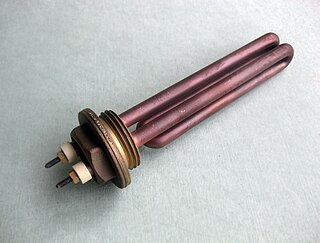
A heating element is a device used for conversion of electric energy into heat, consisting of a heating resistor and accessories. Heat is generated by the passage of electric current through a resistor through a process known as Joule Heating. Heating elements are used in household appliances, industrial equipment, and scientific instruments enabling them to perform tasks such as cooking, warming, or maintaining specific temperatures higher than the ambient.

Housing in Japan includes modern and traditional styles. Two patterns of residences are predominant in contemporary Japan: the single-family detached house and the multiple-unit building, either owned by an individual or corporation and rented as apartments to tenants, or owned by occupants. Additional kinds of housing, especially for unmarried people, include boarding houses, dormitories, and barracks.

Electric heating is a process in which electrical energy is converted directly to heat energy. Common applications include space heating, cooking, water heating and industrial processes. An electric heater is an electrical device that converts an electric current into heat. The heating element inside every electric heater is an electrical resistor, and works on the principle of Joule heating: an electric current passing through a resistor will convert that electrical energy into heat energy. Most modern electric heating devices use nichrome wire as the active element; the heating element, depicted on the right, uses nichrome wire supported by ceramic insulators.
Renewable heat is an application of renewable energy referring to the generation of heat from renewable sources; for example, feeding radiators with water warmed by focused solar radiation rather than by a fossil fuel boiler. Renewable heat technologies include renewable biofuels, solar heating, geothermal heating, heat pumps and heat exchangers. Insulation is almost always an important factor in how renewable heating is implemented.

Underfloor heating and cooling is a form of central heating and cooling that achieves indoor climate control for thermal comfort using hydronic or electrical heating elements embedded in a floor. Heating is achieved by conduction, radiation and convection. Use of underfloor heating dates back to the Neoglacial and Neolithic periods.

A convection heater is a type of heater that uses convection currents to heat and circulate air. These air currents flow throughout the body of the appliance and across its heating element. This process takes advantage of thermal conduction in order to heat the air, reducing its density relative to colder air and causing it to rise.

A heater core is a radiator-like device used in heating the cabin of a vehicle. Hot coolant from the vehicle's engine is passed through a winding tube of the core, a heat exchanger between coolant and cabin air. Fins attached to the core tubes serve to increase surface area for heat transfer to air that is forced past them by a fan, thereby heating the passenger compartment.
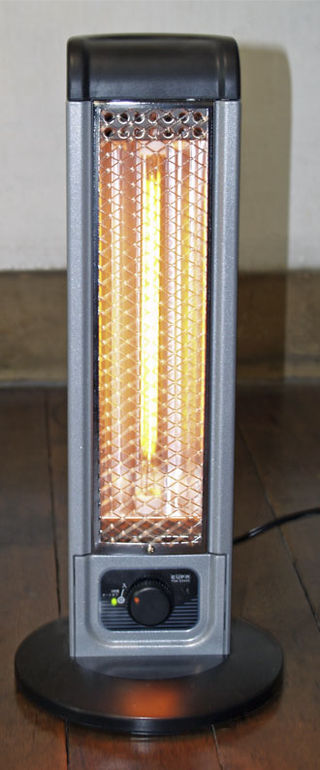
An infrared heater or heat lamp is a heating appliance containing a high-temperature emitter that transfers energy to a cooler object through electromagnetic radiation. Depending on the temperature of the emitter, the wavelength of the peak of the infrared radiation ranges from 750 nm to 1 mm. No contact or medium between the emitter and cool object is needed for the energy transfer. Infrared heaters can be operated in vacuum or atmosphere.

An oil heater, also known as an oil-filled heater, oil-filled radiator, or column heater, is a common form of convection heater used in domestic heating. Although filled with oil, it is electrically heated and does not involve burning any oil fuel; the oil is used as a heat reservoir (buffer).

Dyson Airblade is an electric hand dryer made by the Singapore-based company Dyson, found in public bathrooms across the United Kingdom. It was introduced in the United Kingdom in 2006 and in the United States in late 2007. In 2013 the Airblade Tap was launched, which incorporates Airblade technology into a bathroom faucet enabling washing and drying in a single unit.

Radiators and convectors are heat exchangers designed to transfer thermal energy from one medium to another for the purpose of space heating.
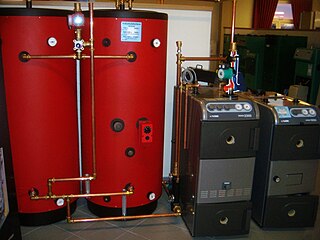
A hot water storage tank is a water tank used for storing hot water for space heating or domestic use.
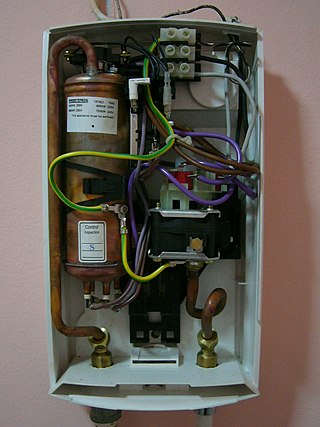
Tankless water heaters — also called instantaneous, continuous flow, inline, flash, on-demand, or instant-on water heaters — are water heaters that instantly heat water as it flows through the device, and do not retain any water internally except for what is in the heat exchanger coil unless the unit is equipped with an internal buffer tank. Copper heat exchangers are preferred in these units because of their high thermal conductivity and ease of fabrication. However, copper heat exchangers are more susceptible to scale buildup than stainless steel heat exchangers.
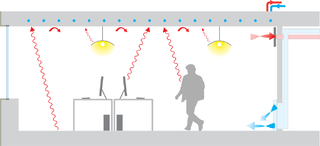
Radiant heating and cooling is a category of HVAC technologies that exchange heat by both convection and radiation with the environments they are designed to heat or cool. There are many subcategories of radiant heating and cooling, including: "radiant ceiling panels", "embedded surface systems", "thermally active building systems", and infrared heaters. According to some definitions, a technology is only included in this category if radiation comprises more than 50% of its heat exchange with the environment; therefore technologies such as radiators and chilled beams are usually not considered radiant heating or cooling. Within this category, it is practical to distinguish between high temperature radiant heating, and radiant heating or cooling with more moderate source temperatures. This article mainly addresses radiant heating and cooling with moderate source temperatures, used to heat or cool indoor environments. Moderate temperature radiant heating and cooling is usually composed of relatively large surfaces that are internally heated or cooled using hydronic or electrical sources. For high temperature indoor or outdoor radiant heating, see: Infrared heater. For snow melt applications see: Snowmelt system.

Airing is the practice of hanging or laying out articles and exposing them to air, and sometimes heat and light. This practice is commonly used to dry many types of fabric. One of the most common methods of drying using airing is the clothesline. It consists of a thin wire from which clothing pieces and bedsheets are hung, using pegs or simply laying the article over the line.



















